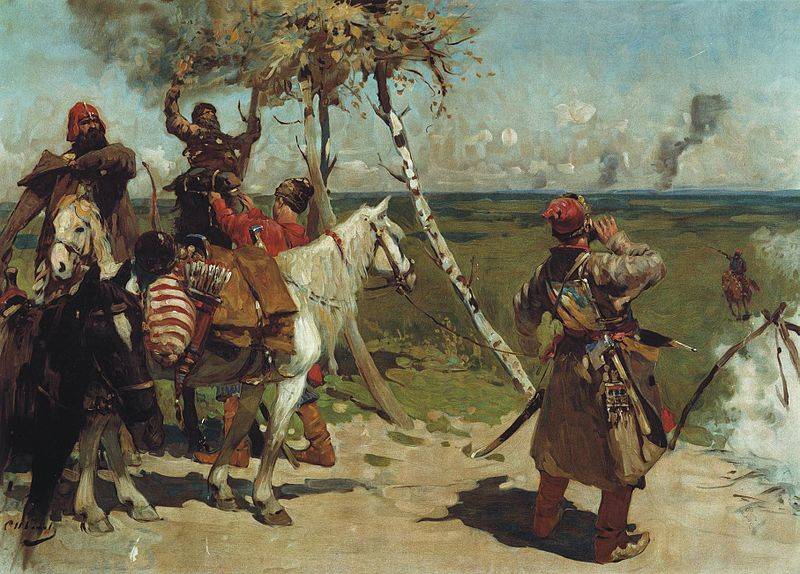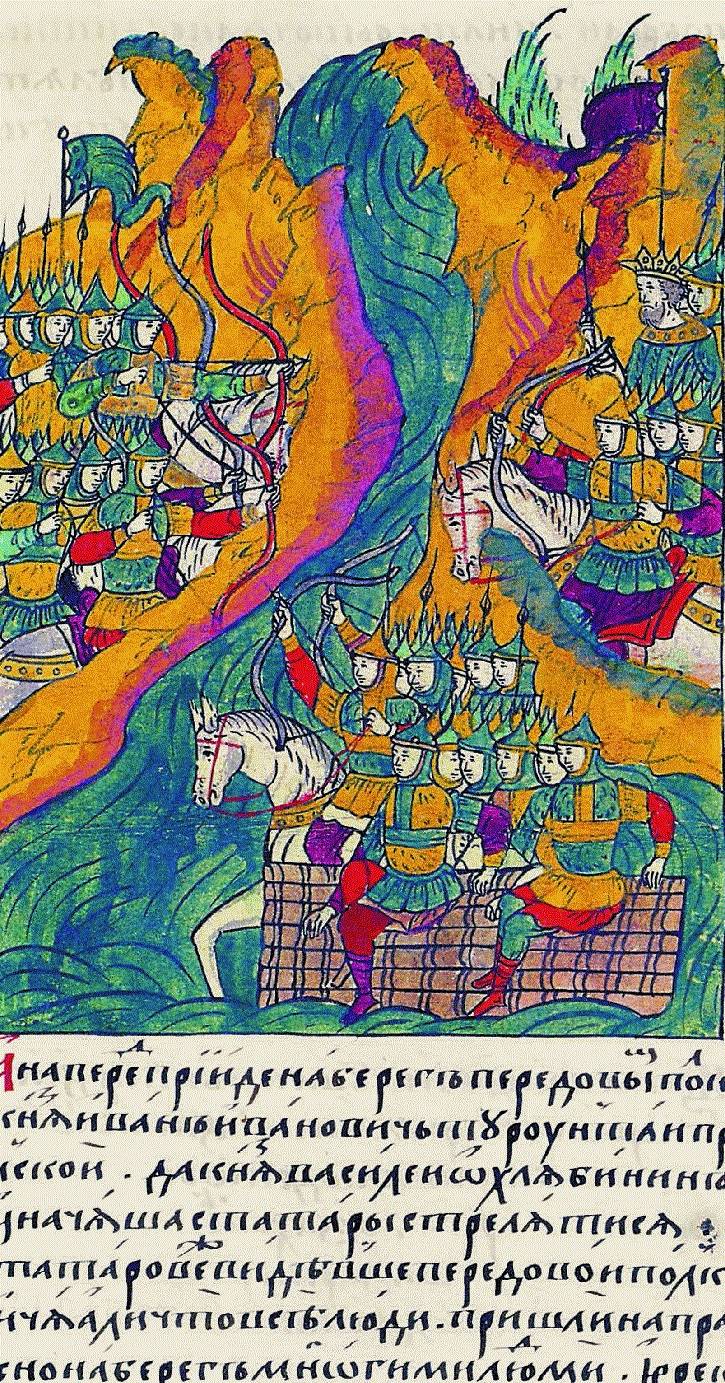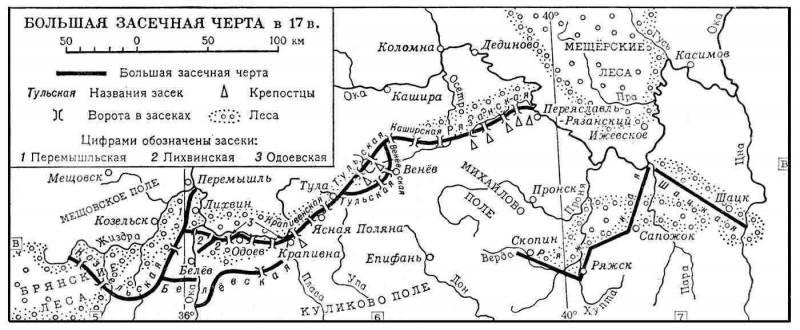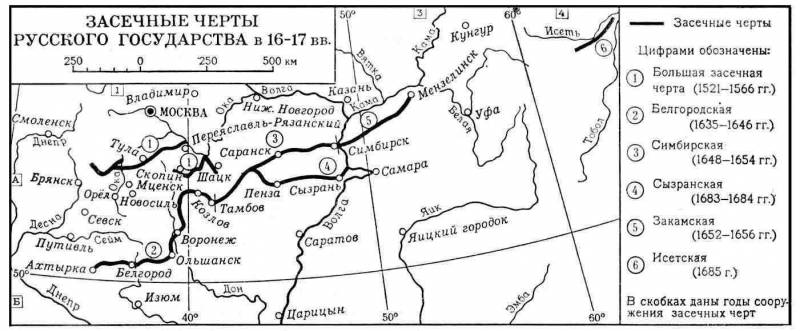War between Moscow and Kazan Khan Safa-Girey

"On the guard border of the Moscow state." Painting by S.V. Ivanov, 1907
The war between Moscow and Kazan continued throughout the reign of Khan Safa-Girey. The fighting alternated with peace negotiations. The Kazan government tried to deceive Moscow and avoid retaliation. The crafty khan first began peace negotiations, and then made surprise attacks on Russian lands. The Kazanians burned down the outskirts of Nizhny Novgorod, Murom and Kostroma, took people away to the full.
Crimean affairs
In 1531, Moscow regained control over Kazan, planting there the Kasimov Khan Dzhan-Ali (Battle on the Volga. The fight between Moscow and Kazan). Crimea did not participate in these events, as there was its own turmoil. The Crimean Khan Saadet-Girey fought with his nephew Islam-Girey (Islyam-Girey). Also, many local feudal lords, led by the powerful Shirin clan, opposed him.
Only in 1532 did the Crimeans renew their pressure on Muscovite Rus. In February, Crimean people went to the Odoev and Tula regions. The raid was led by Tsarevich Buchak, directed by Saadet-Giray. This attack did not come as a surprise. A strong army was located in Tula, headed by the governors Mikhail Vorotynsky, Ivan Lyatsky, Vasily Mikulinsky and Alexander Kashin. The Tatars ravaged several villages on the border and immediately left without engaging in battle with the Russian regiments.
In May 1532, the news came in that the Crimeans were preparing a large campaign to the Crimea. Large additional forces with artillery were sent to defend the southern line. However, there was no major offensive against the Russian Ukrainians this year. Saadet-Girey, with the support of Turkish troops, stormed the Polish-Lithuanian border this year. The Crimeans besieged Cherkassy for a month, but the garrison under the command of the headman of Cherkasy Dashekevich repulsed all attacks. Saadet-Girey left for Crimea, voluntarily renounced the throne and left for Istanbul. The throne was seized by Islam Giray. However, the Sultan's government decided to plant in the Crimea another uncle of Islam - Sahib-Girey (Sahib). Islam retained the post of kalgi, the second person in the hierarchy of the Crimean Khanate. Perekop and Ochakov were his estates.
The ruin of the Ryazan region
In August 1533, a message was received in Moscow about the beginning of a campaign against the Moscow state of the Crimean horde, led by Tsarevich Islam-Girey and Safa-Girey, a former Kazan king who lived in exile in the Crimea and dreamed of returning to Kazan as a winner. The Crimeans gathered 40 thousand troops.
The Russian government did not have accurate data on the movement of the enemy, and took extraordinary measures to protect the border areas. Sovereign Vasily III stood up with reserve regiments in the village of Kolomenskoye. The army of princes Dmitry Belsky and Vasily Shuisky was sent to Kolomna. The regiments of Prince Fyodor Mstislavsky, Peter Repnin and Peter Okhlyabin were sent there. From Kolomna, the cavalry detachments of "Lehki Voivods" Ivan Ovchina-Telepnev, Dmitry Paletsky and Dmitry Drutsky were sent to meet the enemy.
The experience of failure in 1532 and the information received from the prisoners about the strengthening of the "coast" forced the Crimean princes to strike elsewhere. On August 15, 1533, the Grand Duke received news of the arrival of the Tatars near Ryazan. The Crimeans burned out the villages, tried to take the fortress, but were repelled. The Ryazan land has undergone terrible devastation. The Tatar corrals passed through the city's environs, leading to the full of all who did not have time to hide. The Crimeans captured a lot of booty.
The first to enter the area of enemy operations was the detachment of Voivode Paletsky. Near the village of Bezzubovo, 10 versts from Kolomna, the Russians "trampled down" the Crimean detachment that was robbing there. Telepnev-Ovchina with the Moscow nobles defeated the advanced forces of the enemy near Zaraisk. The enemy fled, many drowned in the Sturgeon River. In pursuit, the Russian light regiments ran into the main enemy forces. Telepnev-Ovchina bravely met the enemy, managed to fight off the many times superior enemy. The Tatars considered that the entire Russian army was following Telepnev, did not pursue him and began a hasty retreat to the border. One of the Tatar detachments, cut off from the main forces, was forced to leave by roundabout ways, the Ryazan forests. The Crimeans abandoned their horses and armor, many were beaten by the Ryazan peasants.
To prevent a similar disaster in the future, it was decided to strengthen the serifs. New heaps-notches were cut in the forests. In open places, ditches were dug, ramparts with a palisade were poured. Forts were set up. The system of score lines was installed over a vast area: from Ryazan to Venev, Tula, Odoev and to Kozelsk. It is clear that it was impossible to cover such a border with regiments. The calculation was based on the fact that the serifs would slow down the enemy's cavalry. It will take the Tatars time to find and clear the passages. The raid will lose its surprise. At this time, the patrols will inform the governors of the appearance of the enemy, and the troops will be brought up to the threatened areas. They will occupy the border fortresses, stockades. Will repel the invasion. If the enemy breaks through, then on the way back, such notches will also delay him, allow him to repulse the full. They watched such lines-features and warned of the appearance of the enemy Ryazan and Meshchera Cossacks and other border residents. The scores were updated as needed.
War with Kazan
The death of Tsar Vasily III (December 1533) significantly complicated the position of the Russian state. Another Russian-Lithuanian war began. In 1534, Sigismund I, thinking to take advantage of the infancy of the Grand Duke Ivan IV, demanded the return of all the conquests made by the Grand Duke Vasily, and began a war (Starodub war). Anti-Russian sentiments prevailed in Kazan.
Already in the winter of 1533-1534, Kazan residents raided the Nizhny Novgorod lands, ravaged many villages, and took people to the full. Then raids into the Vyatka lands began. The Moscow government tried to reason with Kazan, but the pro-Russian Khan Dzhan-Ali no longer enjoyed the support of the local nobility. The Kazan feudal lords felt the weakness of Moscow, in which there was no formidable ruler, and the boyars took advantage of the youth of the great sovereign in their own interests. A powerful anti-Russian movement began in the Kazan Khanate. Soon Jana-Ali was overthrown and killed, as well as the Russian advisers. Many supporters of the alliance with Moscow fled from the khanate. Safa-Girey, a longtime enemy of Russia, returned to the khan's throne.
The accession of Safa-Girey led to a new big war on the Volga. In the winter of 1535-1536, the Kazan detachments, due to the mistakes of the Meshchera governors Semyon Gundorov and Vasily Zamytsky, reached Nizhny Novgorod, Berezopolye and Gorokhovets. They burned Balakhna, but then retreated, escaping from the blow of the regiments of the commanders Fyodor Mstislavsky and Mikhail Kurbsky transferred from Murom. The citizens of Kazan left, they were not overtaken. The attack of their detachment on Koryakovo on the Unzha River ended less successfully for the Kazan Tatars. Most of the attackers were killed, the prisoners were taken to Moscow and executed. In July 1536, the Kazanians raided the Kostroma places, destroyed the outpost of Prince Peter Zasekin on the Kusi River. Zasekin himself and the governor Menshik Polev died in the battle. In autumn, Kazan residents went to Galician places.
In January 1537, the troops of Safa-Girey began a new campaign and reached Murom through forests. Taking advantage of the surprise of the attack, the Kazanians tried to seize the fortress. They burned out the villages, but they did not manage to take the fortress. After a three-day siege, having received news of the approach of Russian troops from Vladimir and Meshchera, the Tatars hastily retreated. From near Murom, taking many prisoners, the Kazanians went to Nizhny. They burned the upper posad, but then they were thrown back and went to their borders. At the same time, Russian chronicles noted the appearance of the Kazan and Cheremis (Mari) detachments in the vicinity of Balakhna, Gorodets, Galich and Kostroma.
The overthrow of Safa-Giray and his return
Moscow, worried about the sharp deterioration of the situation on the eastern border, begins to strengthen the borders in the Volga region. In 1535 a new fortress was founded in Perm, 1536-1537 cities were built on the river Korega (Bui-gorod), Balakhna, Meschera, Lyubim. The fortifications in Ustyug and Vologda are being renewed. Temnikov was moved to a new location. After the fires, the fortresses in Vladimir and Yaroslavl are being restored. In 1539, on the border of the Galician district, the city of Zhilansky was built. The category books in 1537 for the first time contain the painting of the voivods on the Kazan "ukraine". The main army under the command of Shah Ali and the governor Yuri Shein was in Vladimir. The regiments were located in Murom, Nizhny Novgorod, Kostroma and Galich. The matter was complicated by the war with Lithuania, it was necessary to keep the main forces on the western borders. In addition, the threat from Crimea also remained.
In the spring of 1538, the Moscow government planned a large campaign against Kazan. However, under pressure from Bakhchisarai, peace negotiations began. They dragged on until the fall of 1539, when the Kazan Khan struck Murom again, and Kazan detachments also appeared in Galich and Kostroma places. The Kazan army, reinforced by the Crimean and Nogai detachments, devastated the Murom and Nizhny Novgorod areas. Then the Tatars retreated to their territory. At the same time, the Kazan detachment of Prince Chura Narykov devastated the Galich places, defeated the Zhilinsky town and went to the Kostroma lands. A stubborn battle took place on the Plyos River. The battle was fierce, four Moscow governors were killed. But the enemy was defeated and fled. All the prisoners were released.
In 1540, Narykov's troops again invaded the Kostroma lands. At the Soldog fortress, the Tatars were overtaken by the army of the governors of Kholmsky and Humpbacked. Kazan were able to repulse the attack and leave. The Russian commanders, Boris Siseev and Vasily Kozhin-Zamytsky, were killed in the battle. In December 1540, the 30-strong Kazan army, with the support of the Crimeans and Nogai, led by Safa-Giray, reappeared under the walls of Murom. The Russian garrison repulsed the attack. The Kazanians captured a large field, it was partially recaptured by the approaching Kasimov Tatars Shah-Ali. Having learned about the approach of the grand ducal troops from Vladimir, Safa-Girey took the army away. The Tatars ravaged all the surrounding villages, and Nizhny Novgorod and partly Vladimir places were also devastated.
The fighting alternated with peace negotiations. The government of Safa-Girey tried to deceive Moscow and avoid retaliation. The crafty khan first began peace negotiations, and then made surprise attacks. The Moscow government, seeing that defensive tactics on the huge Volga borders were ineffective, since it was simply impossible to cover large forests and fend off enemy raids, tried to eliminate the conflict with the forces of the Kazan people themselves. It was necessary to eliminate the main cause of the war - the domination of the Crimean party in Kazan. A search began for contacts with the Kazan opposition, dissatisfied with the actions of the khan, who surrounded himself with the Crimeans.
In 1541, the campaign against Kazan did not take place due to the need to withdraw the regiments to the southern borders, where the Crimean horde approached the Oka. In 1545, two Russian armies, emerging from Nizhny and Vyatka, approached the walls of Kazan. However, the rats of Semyon Mikulinsky and Vasily Serebryany did not achieve much success. Apparently, due to the lack of heavy artillery, the hopes for a mutiny in the city itself against the Crimeans also did not come true. The Kazan Khan launched a terror against the opposition, accusing it of complicity with the Russians, and executed many prominent princes and murzas. Fear for their lives united the Kazan nobility. In January 1546, an anti-Crimean uprising began. Safa-Girey fled to the Nogai horde.
The provisional Kazan government headed by Prince Chura Narykov, Beyurgan-Seit and Prince Kadysh summoned the Kasim ruler Shah Ali to the throne. However, the Kazan nobility made a mistake, refused to let the Russian garrison into the city. Together with the new khan, only 100 Kasimov Tatars were allowed into Kazan. The position of Shah Ali and his supporters was very precarious. The new khan did not enjoy the support of the Kazan people and remained in power for only a month. With the help of the nogays, Safa-Girey again seized the Kazan table. Shah Ali fled to Moscow. Safa carried out a "purge" of the city, the pro-Russian party in Kazan was completely defeated. The war resumed and continued until the capture of Kazan by the troops of Ivan the Terrible.
Southern frontier and victory in 1541
The fighting did not stop on the southern border of Muscovite Rus, where a rare year went by without the appearance of the Crimeans. In 1533 Moscow tried to stake on Islam-Girey. In 1534, Islam again tried to seize power in the Crimean Horde, was defeated by Sahib-Girey, but retained Perekop. The Crimean Khanate was divided: the northern steppes from Perekop were subject to Islam, and Khan Sahib controlled the Crimean Peninsula. Islam tried to negotiate aid with Lithuania and Moscow. The confrontation lasted until 1537, when Islam was finally defeated. He fled to the Nogai horde and was killed there.
The raids of the steppe inhabitants at this time did not differ on a large scale, but they did not stop at all. Islam-Giray was notable for its "precariousness". He willingly promised friendship and alliance for big "commemoration", but did not dare to stop the Crimean Murzas who went to fight in Russia. This forced the Russian government to keep in readiness large forces in the southern direction, which negatively affected the war with Lithuania and Kazan. In 1534, the Crimeans and Azovs made a raid on the Ryazan places on the Pron River.
In the summer of 1535, the patrols failed to detect the enemy in time, and the Tatars invaded Ryazan. The Russian command had to urgently return the regiments to the south, which were previously removed from the "coast" and sent to the besieged by the Polish-Lithuanian army Starodub. With a great delay, the troops returned to the Oka. At the same time, the Tatars did not leave for their uluses and remained “on the field”. The presence of a large Crimean army on the southern border prevented Moscow from providing assistance to Starodub and thwarted the impending campaign against Vilna. As a result, Starodub was taken and burned by the besiegers, the Poles and Lithuanians killed all the inhabitants of the city.
Soon after the end of the military alert in the summer of 1535, the Russian government decided to restore the ancient Ryazan fortress of Pronsk. From year to year, Moscow brought numerous regiments to the "shore" and to the southern places. This has yielded positive results. In 1536, the Crimean attack on the Belevsk and Ryazan places failed, in 1537 - on the Tula and Odoy places. Sahib-Girey began negotiations for peace with Moscow. In 1539, a peace treaty was signed. But the Crimean princes and Murza were not going to observe it. The raids continued. Already in October 1539, the detachments of Tsarevich Amin (Emin-Girey), the son of Sahib-Girey, broke through to the vicinity of Kashira. Having reached the Oka to the east of this city, the Crimeans captured many prisoners and left with impunity to their uluses.
In the fall of 1540, the fragile world was destroyed. The Crimean Khan decided to take advantage of the fact that the Russians were going to march to Kazan. He planned to repeat the pogrom of Moscow Russia in 1521 (Crimean tornado). Having received help from Turkey, in July 1541 the Crimeans set out on a campaign. The Khan gathered an army of 40, reinforced by Turkish infantry and artillery, Nogai and Astrakhan detachments.
In Moscow, they learned in time about the preparation of a large campaign of the Crimean Horde. This was reported by fugitive polonyans and reconnaissance detachments sent to the "field". Russia sends an army to the southern line. The main forces under the command of Dmitry Belsky were stationed at Kolomna. Other regiments took up positions on the Oka. In Zaraisk, the troops were led by princes Semyon Mikulinsky and Vasily Serebryany, near Ryazan - Mikhail Trubetskoy, in Tula - princes Pyotr Bulgakov and Ivan Khvorostinin, in Kaluga - Roman Odoevsky. In reserve, if the enemy breaks through the Oka, the army of Prince Yuri Bulgakov and Tsarevich Shigaley of Shibansky (namesake of Shah-Ali expelled from Kazan) is located on the Pakhra River. The Kasimov army of Shah Ali covered the eastern line. Moscow itself was prepared for defense. Russian forces numbered 25-30 thousand soldiers.
At the end of July 1541, the Crimean troops appeared on the Russian "Ukraine" and tried to take Zaraysk. The Crimeans could not take the new stone fortress and went to the Oka. On July 30, the Tatars were on the Oka near Rostislavl. Russian regiments were stationed on the other side. The reserve regiments from Pakhra also came here. In their place, new regiments were sent with voivods Vasily Shchenyatev and Ivan Chelyadnin. Under the cover of artillery, the Crimean cavalry tried to force the river, but the arrival of Russian reinforcements forced the khan to stop the attack. In the evening, almost all Russian regiments and a large "outfit" arrived at this place. According to Russian sources, Moscow gunners in an artillery duel proved to be more skillful than the Turkish ones, “they beat many Tatars to the dobras and smashed many of the guns of the Turks”.
Sahib did not dare to fight and retreated from the Oka. The Crimeans tried to break through in the Pronsk direction. On August 3, the Tatars laid siege to the Ryazan fortress. After heavy artillery shelling, the Crimeans launched an assault. The Russian garrison, weakened by the allocation of soldiers for the defense of the line on the Oka, nevertheless repulsed the attack. Having received the news that the main forces of the Russian army were coming here, the khan threw weights, including artillery, and took the troops into the steppe. His son Amin separated from the main forces and tried to destroy the Odoy places. Here he was defeated by the governor Vladimir Vorotynsky.
After the great victory of 1541, a new southern border was secured in the south. The old defensive line on the Oka and Ugra became a reserve, rear line. The new border now ran along the line Kozelsk - Odoev - Krapivna - Tula - Zaraysk - Ryazan. Pronsk and Mikhailov, set up in 1551, were the foremost outposts “in the field”.
After the failure of 1541, the Crimeans mainly tried to pass in less fortified places in the Severshchina and Ryazan regions. These raids were no longer a big threat to Moscow.

Miniature of the Obverse Chronicle Collection of the 1541th century: the battle of the Russians and Tatars on the Oka in XNUMX


Information